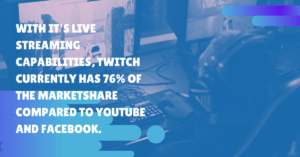Business Insider estimates that in 2022, brands will spend up to $15 billion on influencer marketing campaigns alone which is a large portion of marketing dollars being allocated by companies. With that type of financial commitment, marketers need to accurately track their campaigns. One of the biggest challenges can be how to make a direct connection between influencer marketing and the point of sale.
Beyond “Brand Awareness”
Influencers can help move the needle on brand awareness by producing instant credibility to the company they are promoting based on the Influencer’s endorsement. While this can be important to your brand, there are other important data points that should be considered.
By-Platform Data
Different platforms should be used to reach different audiences and demographics for your influencer campaign based on what your campaign goals are.
For example, beautiful photos of your product belong on Instagram, while eye-catching videos will perform better on Facebook or YouTube. Below are some important performance indicators by platform:
- Facebook and LinkedIn can typically be measured by shares, comments, click-throughs, and reactions (i.e. likes). Both platforms have a wider audience reach amongst middle-aged adults than other social networks.
- On a blog, engagement can be measured by traffic, shares, click-throughs, and comments at the end of the post. Blog demographics vary by subject matter and reach is typically more segmented.
- On a Snapchat channel, engagement can include screenshots and comments. A majority of Snapchat users according to the Pew Research Center are aged between 25 and 29.
- YouTube can be measured by approval or disapproval of a video and by views. Over 90% of 18-44-year-old internet users watch videos on YouTube making it an excellent platform for your influencer campaign.
- Younger users depend on Twitter with most of their users being between the ages of 18 to 34 according to Statista. Engagement can be measured by re-tweets, likes, followers and replies.
- Instagram users tend to be very young – in their teens and twenties – very active and loyal. Measurement includes follower growth, views on stories, likes, impressions, saves, and reach.
Return on Content
Discovering your return on content is key to any successful influencer program. Always magnify influencer content across your owned and operated channels by re-posting and engaging with influencer-created content upon publication to maximize the immediate impact of the partnership.
Brands should also be aggregating influencer content into a microsite or dedicated campaign to enhance its impact. Syndicating your influencer content by partnering with a trusted provider creates opportunities for brands to accurately measure the impact of influencer-produced content across key engagement metrics such as time on content and scroll depth.
You can also get the metrics that matter to your bottom line like ROI and total sales and revenue from a campaign through comprehensive influencer marketing tools to truly understand how you’re getting a return on the content you and your influencers create. Here are some metrics to dive into:
Overall Campaign Engagement
It is important to look at your influencer campaign holistically and capture the many engagement touchpoints listed above including activations, reach, views, likes, and downloads. By accurately reporting and analyzing your campaign engagement, it will be far easier to deem if the cost is worth the result.
Brand Values Gauge
While it is beneficial to empower your influencer through access to your brand, you should also not align with an influencer who has exhibited poor misconduct or behavior. A good influencer should understand your brand’s voice and be a good representation of what you stand for.
Website Traffic
Utilizing web site traffic in order to measure the success of your influencer campaign should also not be overlooked. It can tell us the complete picture of engagement through page views, time users spent on site, referrals (links driving traffic to your site), new users and total sessions (sessions recorded during a date range).
Downloads/Signups
Downloads and sign-ups might be soft conversions but they are good indicators of interest beyond likes, follows and retweets. Influencers can drive lead generation and highly engaged users are more likely to share the product or service with friends which ultimately leads to sales.
Sales
Influencers can have a big impact on your bottom line and influencer campaigns are driving tangible sales which are tracked using custom links, redemption codes or landing pages. Consumers are looking for opinions, concerns, and recommendations from trusted experts and peers and what better way to add that value to your campaign by choosing the right influencer. Partnering with influencers that advocate for your brand or showcase your product will increase sales and will highlight your product or service.
If you’re looking for influencer marketing data all in one place, you’re looking for Sideqik. Sideqik helps you through the entire campaign process–from finding the right influencer to creating the perfect content and then measuring the effectiveness of the whole process.
Nancy Rothman
Latest posts by Nancy Rothman (see all)
- How Travel Brands Can Use Influencer Marketing to Stay Afloat as the Pandemic Continues - February 22, 2022
- Influencer Marketing Trends to Watch (And Prepare For) in 2022 - December 31, 2021
- A Guide: How to Recruit the Right Influencers for Your Brand - December 30, 2021







